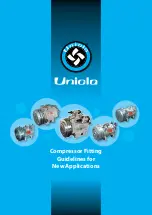
27
Before the oil separator is installed, an initial charge of oil
must be added to it. This initial charge of oil is the amount
that is needed to just float the needle valve float. This
amount of oil will stay in the oil separator when in operation
and will seal the needle and prevent damage to the float
mechanism. Oil Precharge is very important. Failure to
Precharge the separator sump may result in damage to the
oil return float mechanism by the turbulent hot gas bouncing
the float and causing the needle valve to leak.
New systems from the factory have been Precharged.
Use the same type of oil that is in the compressor crankcase.
See the table below for the proper amount of oil to be
Precharged.
Table 20. AC & R Models
HELICAL MODEL
NO.
OIL PRECHARGE
S-5180, S-5181
4 oz. / 11 cl
S-5182, 85, 87, 88
14 oz. / 40 cl
S-5190, 92, 94
40 oz. / 114 cl
S-5200 / S-5410 series
25 oz. / 71 cl
CONVENTIONAL
MODEL NO.
OIL PRECHARGE
S-5500 series
12 oz. / 34 cl
S-5600 series
30 oz. / 86 cl
S-1900, S-5700 series
25 oz. / 71 cl
S-5800 series
12 oz. / 34 cl
Temprite Models
The
Temprite brand used is the coalescent filter type
separator. Because this filter is finer than a filter/drier, it will
pick up any and all effluent and dirt circulating in the system
down to 0.3 microns. These filters should be changed after
24 to 48 hours of initial run time. A second filter is supplied
with the system for this purpose. If the filter becomes dirty, it
will not function at its optimum performance level. In the
event of a compressor burnout, all the effluent will be
contained in the oil separator.
When the
Temprite coalescent separator is used, the
separate oil reservoir is not required. The oil separator
serves the additional function as the reservoir. There is a
constant pressure valve used between the oil return outlet
and the oil level regulators to maintain a low pressure oil flow
to the regulators. This valve should be adjusted to maintain
oil pressure to the level regulators at 20 psig higher than the
highest suction pressure group. This valve can be adjusted
by removing the external cap and rotating the adjusting spring
in or out as required.
The valve currently used is manufactured by
Parker and is a
model A7 constant pressure expansion valve with a range of
0 to 90 psig. Temprite Part No. is 67070000. An alternative
valve manufactured by
Sporlan is Model ADRI - 1
1
/
4
- 0/90.
Temprite Valve Adjustment
Turn in (clockwise) to increase pressure. Turn out
(counterclockwise) to decrease pressure. Approximately 7
psi per turn. Factory set at 40 psi
±
2.
Figure 17. Temprite Oil System
Table 21. Temprite Models
TEMPRITE MODEL
NO.
OIL PRECHARGE
922R, 923R
77 oz. / 2.2 L
924R , 925R
109 oz. / 3.22 L
926R, 927R
1.8 gal./ 6.7 L
928R
3.5 gal. / 13.25 L
930R
5.7 gal . / 21.25 L
Oil Level Regulators
The
A C & R adjustable oil regulators are designed to feed oil
between 1/4 and 5/8 sight glass levels. The regulator may
adjust beyond this range due to the actual oil pressure.
Adjustable regulators include an adjustment mechanism to
raise or lower the oil set point. The
A C & R design
eliminates the need to shut the system down in order to
adjust the oil level. The oil level may be adjusted while the
system is under pressure and running. Adjust the oil level by
removing the seal cap, the locking disk (S-9130 & S-9190
series only), and rotating the adjustment clockwise to lower,
counter clockwise to raise the oil level. Replace the cap and
locking disk when done. Each full turn of the adjustment
mechanism moves the oil level approximately 1/16”. Oil
levels on these regulators are typically factory set just below
1/2 sight glass.
All level regulators have a operating pressure differential
range that should not be confused with its working pressure.
The operating differential is the difference of pressure
between the oil feeding into the regulator and the component
where the regulator is controlling oil level. Specifically, the
reservoir pressure minus the crankcase pressure. If the
differential pressure is too low for that regulator, insufficient
oil flow to the compressor may result. If the differential
pressure is too high, the regulator will overfill.










































